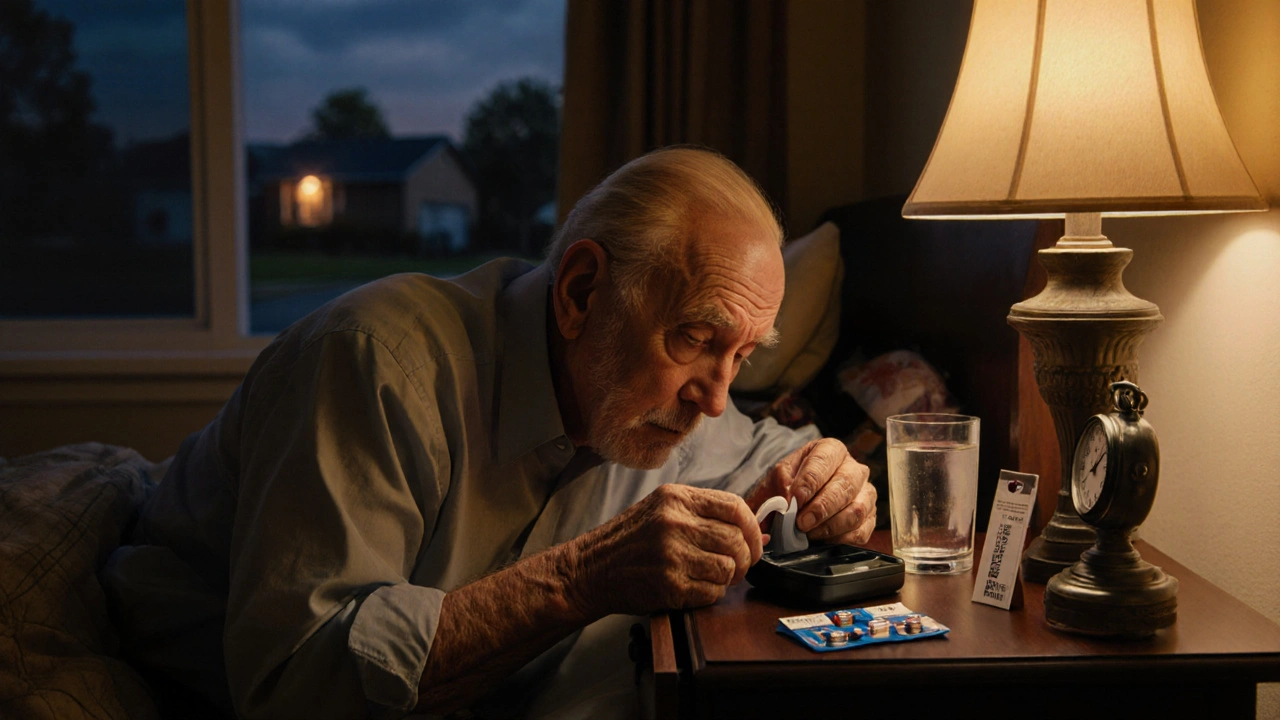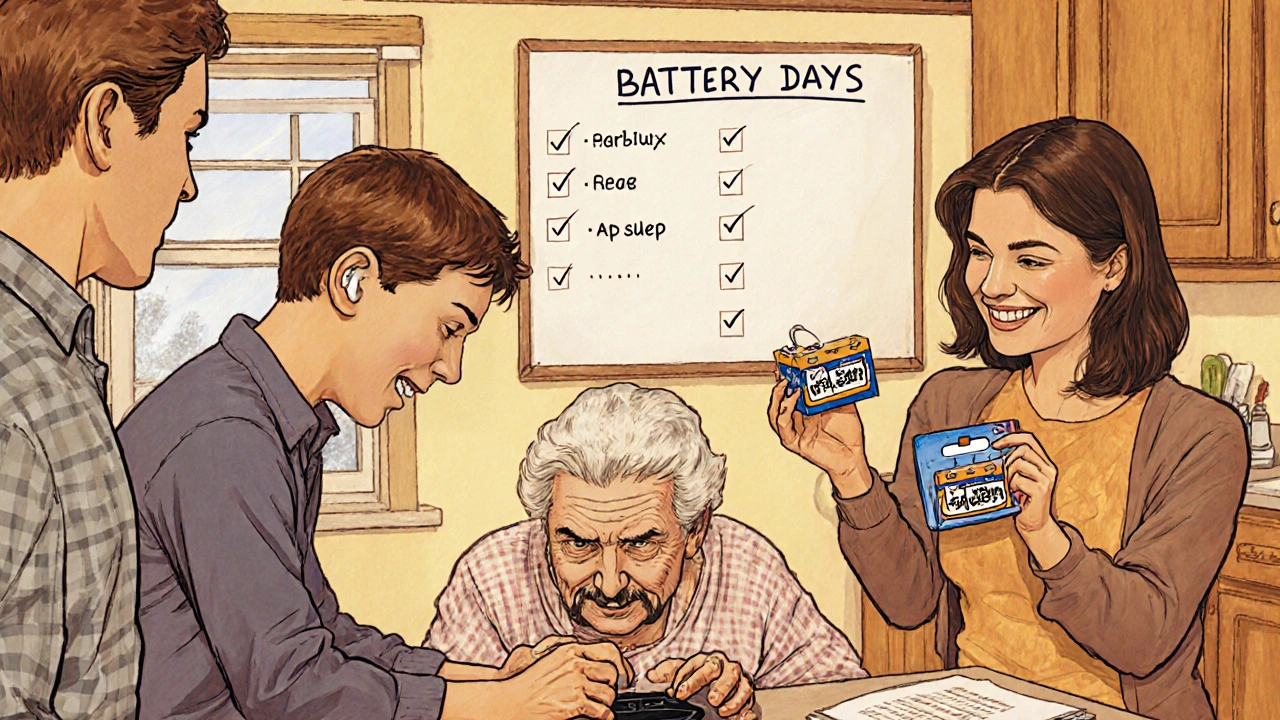Hearing Aid Batteries vs. Rechargeables: What Works Best for You?

Choosing Between Disposable and Rechargeable Hearing Aid Batteries
When you first get hearing aids, one of the first real-life decisions you’ll face isn’t about sound quality or brand-it’s about power. Do you go with disposable hearing aid batteries or switch to rechargeable hearing aids? It’s not just a technical choice. It’s about your daily life, your hands, your travel habits, and even your environmental footprint.
For years, disposable zinc-air batteries were the only option. Small, cheap, and reliable, they fit into nearly every hearing aid model. But today, more than two-thirds of new hearing aids sold in the U.S. come with built-in rechargeable batteries. That’s not a fluke. It’s a shift driven by real user needs.
How Disposable Hearing Aid Batteries Work
Disposable hearing aid batteries are zinc-air cells. That means they don’t work until you pull off the tab and let air in. Once activated, they last between 5 to 16 days, depending on how much you use your hearing aids and what features you turn on-like Bluetooth streaming or noise reduction.
There are four standard sizes:
- Size 10 (yellow): For smallest devices, lasts 80-100 hours
- Size 312 (brown): Most common, 175-225 hours
- Size 13 (orange): For larger BTEs, 225-275 hours
- Size 675 (blue): For high-power devices, 275-325 hours
These batteries are mercury-free now, but they still contain zinc and manganese. If tossed in the trash, they end up in landfills. In the U.S. alone, hearing aid users throw away about 1,500 tons of these batteries every year. That’s the weight of 100 school buses.
The Rise of Rechargeable Hearing Aids
Rechargeable hearing aids use lithium-ion batteries-the same kind in your phone or earbuds. They’re built into the device, so you don’t swap them out. Instead, you place your hearing aids in a charging case overnight. Most models give you 24 hours of use on a full charge. Some, like the Phonak Audeo, can give you 8 hours of power after just 30 minutes of charging.
These batteries last about 300 to 500 charge cycles. That’s roughly 1 to 1.5 years before they start losing capacity. At that point, you’ll need to take them to an audiologist for replacement. Unlike disposable batteries, you can’t just buy a new one at the drugstore.
Rechargeable models work in BTE, RIC, and some ITE hearing aids-but not in completely-in-canal (CIC) devices. The space just isn’t there.
Pros and Cons: Side by Side
| Feature | Disposable Batteries | Rechargeable Batteries |
|---|---|---|
| Power Duration | 5-16 days per battery | 24 hours per charge |
| Charging/Replacement Time | Seconds to swap | 3-6 hours to fully charge |
| Initial Cost | Low ($6-$9 for a 6-pack) | Higher (includes charging case) |
| Annual Cost | $30-$150 | $0 after first year (battery replacement every 1-1.5 years) |
| Portability | High (fits in wallet) | Requires charger |
| Dexterity Required | High (tiny tabs, small compartments) | Low (just drop in case) |
| Environmental Impact | High (100-200 batteries/year) | Low (1-2 replacements/year) |
| Reliability | High (no electronics to fail) | Medium (charging circuit can break) |
| Compatibility | All models, including CIC | Only BTE, RIC, some ITE |

Who Benefits Most from Rechargeable Hearing Aids?
If you have arthritis, shaky hands, or trouble seeing small objects, rechargeables are a game-changer. A 2023 survey by the Arthritis Foundation found that 35% of hearing aid users over 70 struggle with fine motor tasks. For them, fumbling with a tiny battery tab isn’t just annoying-it’s exhausting.
One user on HearingTracker.com wrote: “Switching to rechargeables was life-changing. I no longer struggle with those tiny batteries every 10 days.” That’s not an outlier. In Reddit’s r/Hearing community, 68% of users over 65 prefer rechargeables. The reason? They forget to change batteries less. They don’t panic when one dies mid-day. They just leave their aids in the charger before bed.
For people with a regular routine, rechargeables offer a “set it and forget it” experience. Ninety-two percent of successful users plug their aids in right after taking them out at night. It becomes as automatic as brushing your teeth.
When Disposable Batteries Still Make Sense
Rechargeables aren’t perfect. If you’re traveling for days without access to electricity-hiking, camping, or flying overseas-you need backups. You can’t charge your aids on a plane or in a remote cabin. That’s why many people still carry 6-12 disposable batteries in their wallet.
One Reddit user, “TravelingTom,” says: “When I’m hiking for days without power, disposables are my only option. I carry 12 spares for a week-long trip.”
Also, if your hearing aid is a CIC model, you don’t have a choice. Rechargeable batteries simply don’t fit. And if you’re someone who doesn’t like relying on electronics-maybe you’ve had chargers fail before-you might prefer the simplicity of a battery you can replace in seconds.
Cost Over Time: The Real Math
At first glance, disposable batteries look cheaper. A 6-pack costs $6-$9. But if you use two hearing aids and change batteries every 10 days, you’ll go through 72 batteries a year. That’s $72-$108 annually.
Rechargeable systems cost more upfront-often $200-$400 extra for the charging case. But after 18 to 24 months, you’ve saved more than you spent on batteries. And after that? You’re only paying for one battery replacement every 1-1.5 years, which usually costs $80-$150 and is often covered under warranty.
Ohio Hearing’s 2-year cost comparison study found that after two years, rechargeable users saved an average of $120 compared to those using disposables.
Environmental Impact: It’s Bigger Than You Think
Every year, the average hearing aid user throws away 300-400 disposable batteries. In the U.S., that adds up to 1.2 million pounds of battery waste. That’s not just plastic and metal-it’s zinc and manganese, which can leach into soil and water if not disposed of properly.
Thirty-eight U.S. states now require these batteries to be recycled separately. But most people don’t know that. They toss them in the trash.
Rechargeable users replace their batteries once every 1-1.5 years. That’s a 95% reduction in waste. The EPA estimates this saves over a million pounds of battery waste annually just in the U.S.
And here’s the kicker: 65% of new hearing aid users in 2023 said environmental impact influenced their choice. That’s not a niche concern anymore. It’s a mainstream factor.

What Experts Say
Dr. Sarah Jones, Chief Audiologist at Alpaca Audiology, says: “Rechargeable hearing aids reduce battery-related frustration by 78% in our patient satisfaction surveys.”
But Dr. Michael Chen from Johns Hopkins warns: “Rechargeable systems introduce additional failure points-charging circuits, battery management systems, external chargers. Service needs go up 15-20%.”
Consumer Reports’ 2023 ratings reflect this trade-off: rechargeables scored 4.2/5 for convenience but only 3.7/5 for reliability. Disposables scored 3.5/5 for convenience but 4.3/5 for reliability. It’s a classic trade-off: ease vs. durability.
The American Academy of Audiology’s 2023 position statement says it plainly: “Rechargeable technology is the future, but disposable batteries remain essential for travelers and people in areas with unreliable power.”
What’s Next for Hearing Aid Power?
Technology is moving fast. Widex’s 2023 Evoke CR model now works in temperatures from 32°F to 104°F-no more battery drain in cold weather. Starkey’s new models use wireless charging. You don’t even need to line them up perfectly in the case.
On the disposable side, Rayovac’s Ultra Plus batteries last 25% longer thanks to better air flow design.
And researchers at Stanford are testing solid-state batteries that could give you 48 hours of power on a single charge. That’s two full days. If that hits the market, the need for disposables could shrink even further.
Industry analysts predict that by 2027, 85% of new hearing aids will be rechargeable. By 2030, disposables may make up less than 25% of the market.
How to Decide
Ask yourself these questions:
- Do I have trouble gripping small objects or seeing tiny tabs?
- Do I travel often without access to outlets?
- Am I okay with a nightly routine of charging?
- Do I mind spending more upfront to save money and waste later?
- Is my hearing aid style compatible with rechargeables?
If you answered yes to the first, third, or fourth question, rechargeables are likely the better fit. If you answered yes to the second, or if your hearing aid is a CIC model, keep disposables on hand-or consider carrying a portable charger.
Many people use both. They have rechargeables at home and a small pack of disposables in their bag for trips. That’s not a failure-it’s smart planning.
Final Thoughts
This isn’t about which is “better.” It’s about which fits your life. Rechargeables offer convenience, cost savings, and environmental benefits. But disposables offer simplicity and freedom from outlets.
Technology is shifting toward rechargeables-and for good reason. But that doesn’t mean disposables are obsolete. They’re still the right tool for some people. The key is knowing your needs, not just following trends.
If you’re unsure, talk to your audiologist. Bring up your daily routine, your travel habits, and your hand strength. They’ve seen this choice a thousand times. They can help you pick the one that won’t just power your hearing aids-but make your life easier.
Can I use rechargeable batteries in my old hearing aids?
No. Rechargeable hearing aids are built with internal lithium-ion batteries and a charging circuit. You can’t retrofit older models that were designed for disposable batteries. If you want rechargeable power, you’ll need new hearing aids.
How long do rechargeable hearing aid batteries last before needing replacement?
Most rechargeable hearing aid batteries last between 300 and 500 charge cycles, which equals about 1 to 1.5 years of daily use. After that, they hold less charge-usually below 80% of their original capacity. At that point, they need professional replacement, which your audiologist can do.
Are disposable hearing aid batteries dangerous to the environment?
Yes. While they’re mercury-free now, they still contain zinc and manganese, which can leak into soil and water if thrown in regular trash. In 38 U.S. states, it’s required by law to recycle them separately. Many pharmacies and hearing clinics offer free recycling bins.
What should I do if my rechargeable hearing aids won’t charge?
First, check that the charging case has power and the contacts are clean. Dirt or earwax can block the connection. If that doesn’t work, try a different outlet or charging cable. If the problem continues, contact your audiologist. It could be a faulty battery, charging circuit, or case-most are covered under warranty for the first 1-2 years.
Do rechargeable hearing aids work during power outages?
Only if you’ve charged them before the outage. That’s why many users keep a small supply of disposable batteries on hand for emergencies. Some newer models even come with portable charging cases that you can charge via USB-useful during travel or storms.
Can I use generic chargers with my rechargeable hearing aids?
No. Each brand uses proprietary charging systems. Using a third-party charger can damage your hearing aids or void your warranty. Always use the charger that came with your device or one approved by the manufacturer.
How many disposable batteries should I keep on hand?
Keep at least a 30-day supply-about 24 to 30 batteries-for both hearing aids. That’s enough to cover unexpected delays in restocking. Only 38% of users do this, according to Ohio Hearing’s survey. Running out mid-week is a common complaint among disposable battery users.
Do rechargeable hearing aids perform better than those with disposable batteries?
They offer more consistent power. Disposable batteries gradually lose voltage as they drain, which can cause your hearing aid to sound quieter or distorted before you even realize the battery is low. Rechargeable batteries maintain steady voltage until they’re nearly empty, giving you more reliable sound quality all day.